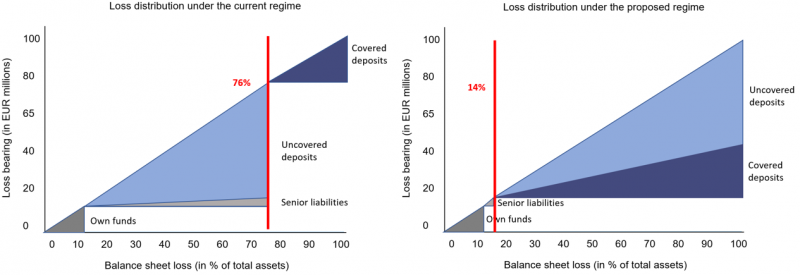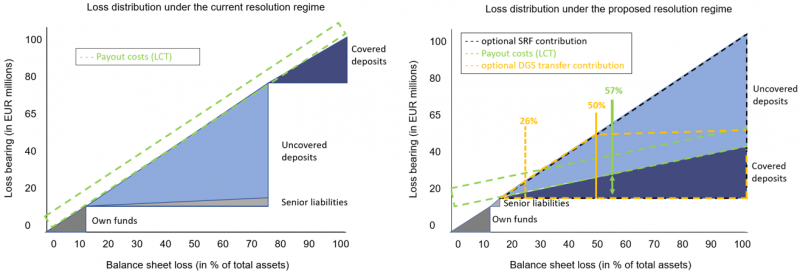References
Alanis, E, H Beladi, M Quijano. 2015. Uninsured deposits as a monitoring device: Their impact on bond yields of banks. Journal of Banking and Finance 52, 77–88.
Autonomous. 2023. European Banks – Pushing depositor preference. 21 April 2023.
Balke, F, M Wahrenburg. 2019. Credibility of Bank Resolution Regimes and Market Discipline: Evidence from Corporate Deposits. Available at SSRN: https://ssrn.com/abstract=3494263 or http://dx.doi.org/10.2139/ssrn.3494263.
Basel Committee on Banking Supervision. 2010. Basel III: A global regulatory framework for more resilient banks and banking systems. Basel III: A global regulatory framework for more resilient banks and banking systems – post BCBS meeting – revised version June 2011 (bis.org).
Bennett, R L, H Unal. 2015. Understanding the Components of Bank Failure Resolution Costs. Financial Markets, Institutions and Instruments 24. 349–389.
Berg, J, S U Lind. 2023. Why there is no need to stray from the original ideas behind the Bank Recovery and Resolution Directive. SUERF Policy Note, Issue No 306, March 2023.
Board of Governors of the Federal Reserve System. 2023. Review of the Federal Reserve’s Supervision and Regulation of Silicon Valley Bank. Washington, D.C. (https://www.federalreserve.gov/publications/files/svb-review-20230428.pdf).
Calomiris, C W, C M Kahn. 1991. The Role of Demandable Debt in Structuring Optimal Banking Arrangements. American Economic Review 81. 497–513.
Calomiris, C W, M Jaremski. 2019. Stealing Deposits: Deposit Insurance, Risk Taking and the Removal of Market Discipline in Early 20th Century Banks. Journal of Finance 74. 711–754.
Calomiris, C W. 2023. That 80s feeling: How to get serious about bank reform this time and why we won’t. 27 March. https://cepr.org/voxeu/columns/80s-feeling-how-get-serious-about-bank-reform-time-and-why-we-wont.
Cebenoyan, A S, F Cebenoyan. 2008. Subordinated debt, uninsured deposits, and market discipline: evidence from U.S. bank holding companies. Economics Working Paper Archive at Hunter College 421, Hunter College Department of Economics.
Danisewicz, P, D McGowan, E Onali and K Schaeck. 2018. Debt Priority Structure, Market Discipline, and Bank Conduct. The Review of Financial Studies 31, p. 4493–4555.
Cecchetti, S, K Schoenholtz, and L White. 2023. The dangerous role of America’s weird lenders-of-next-to-last resort. Financial Times. Alphaville. August 17th.
European Banking Authority (EBA). 2021. Call for advice regarding funding in resolution and insolvency. EBA/REP/2021/31.
European Central Bank. 2023. Opinion of the European Central Bank of 5 July 2023 on amendments to the Union crisis management and deposit insurance framework (CON/2023/19).
European Commission (EU COM). 2013. Directive 2013/36/EU of the European Parliament and the Council of 26 June 2013 on access to the activity of credit institutions and the prudential supervision of credit institutions and investment firms, amending Directive 2002/87/EC and repealing Directives 2006/48/EC and 2006/49/EC.
European Commission (EU COM). 2014. Directive 2014/59/EU of the European Parliament and the Council of 15 May 2014 establishing a framework for the recovery and resolution of credit institutions and investment firms and amending Council Directive 82/891/EEC, and Directives 2001/24/EC, 2002/47/EC, 2004/25/EC, 2005/56/EC, 2007/36/EC, 2011/35/EU, 2012/30/EU and 2013/36/EU, and Regulations (EU) No 1093/2010 and (EU) No 648/2012, of the European Parliament and of the Council.
Federal Deposit Insurance Corporation (FDIC). 2017. Crisis and response. An FDIC History, 2008–2013.
Federal Deposit Insurance Corporation (FDIC). 2023. FDIC’s supervision of Signature Bank. Washington, D.C. (FDIC’S SUPERVISION OF SIGNATURE BANK).
Greenbaum, S I, A V Thakor (1997) Contemporary Financial Intermediation. The Dryden Press. Fort Worth.
Hardy, D. 2014. Bank resolution costs, depositor preference and asset encumbrance. Journal of Financial Regulation and Compliance 22. 96-114.
Huertas, T. 2022. Reset Required: The Euro-area Crisis Management and Deposit Insurance Framework. Journal of Financial Regulation 8, 187–202. https://doi.org/10.1093/jfr/fjac007.
Maddaloni, A M, G Scardozzi. 2022. The New Bail-In Legislation: An Analysis of European Banking Resolution. Working Papers (Dipartimento di Economia Aziendale). Università degli Studi Roma Tre. Rome.
Posch, M, S W Schmitz, P Strobl. 2018. Strengthening the euro area by addressing flawed incentives in the financial system. Monetary Policy & the Economy Q2/18. 34–50.
Potter, S. 2016. Discussion of ‘Evaluating Monetary Policy Operational Frameworks’ by Ulrich Bindseil. Remarks at the 2016 Economic Policy Symposium at Jackson Hole, WY, August 26. https://www.newyorkfed.org/newsevents/speeches/2016/pot160826.
Restoy, F. 2023. The Quest for Deposit Stability. SUERF Policy Note, Issue No 318.
Schmitz, S W, J Eidenberger. 2021. Einlagensicherung und Finanzmarktstabilität. in: N. Raschauer and T. Stern (eds.), Einlagensicherung. Linde-Verlag, Vienna 2021. pp. 75–105.
Sif Larsen, C, A Dyrberg Rommer. 2021. Crisis management of credit institutions: Senior unsecured creditors must prepare for bail-in. SUERF Policy Brief, No 69. https://www.suerf.org/docx/f_860e6390db45d650def1b4fa0c7dd667_22787_suerf.pdf
Stiglitz, J. 1992. The S&L Bailout. in J R Barth and R D Brumbaugh Jr. (eds.), The Reform of Federal Deposit Insurance: Disciplining the Government and Protecting Taxpayers, Harper Business, pp. 1-12.
Veron, N. 2023. Opinion: Fully reimbursing SVB depositors may prove to be a bad move. CNN Opinion. 16 March. Opinion: Fully reimbursing SVB depositors may prove to be a bad move | CNN.
List of acronyms
BCBS: Basel Committee on Banking SupervisionBasel Committee on Banking Supervision
BRRD: Bank Recovery and Resolution Directive
CET1: Common Equity Tier 1
CMDI: Crisis Management and Deposit insurance
CMU: Capital Markets Union
CRD: Capital Requirements Directive
DGS: Deposit Guarantee Scheme
EDIS: European Deposit Insurance System
ESM: European Stability Mechanism
EU: European Union
EU COM: European Commission
FDIC: Federal Deposit Insurance Corporation
FOLTF: Failing Or Likely To Fail
LCR: Liquidity Coverage Ratio
LCT: Least Cost Test
MREL: Minimum Requirement for Own Funds and Eligible Liabilities
NBFI: Non-bank Financial Intermediaries
NCA: National Competent Authority
NRA: National Resolution Authority
O-SII: Other Systemically Important Institutions
PIA: Public Interest Assessment
SME: Small and Medium-sized Enterprises
SRF: Single Resolution Fund
SRMR: Single Resolution Mechanism Regulation
SSM: Single Supervisory Mechanism
SVB: Silicon Valley Bank
SyRB: Systemic Risk Buffer
TLOF: Total Liabilities and Own Funds






